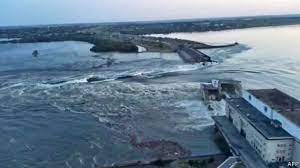
A massive dam in the south of Ukraine, in an area under Russian control, has been destroyed in what is believed to be a deliberate attack, flooding great swathes of land and causing tens of thousands of people to evacuate their homes in the surrounding areas, with as many as 80 towns and villages likely to be affected.
Both warring nations are blaming each other for the destruction of the Kakhovka dam, with the Ukrainians suggesting that it was carried out to slow their counter-offensive which was just beginning, and was likely to use the road over the dam to advance into Russian-held territory.
The Russians meanwhile said they believed it was done to detract from what they announced were the failures of Ukraine’s counter-offensive, and to deprive Crimea of fresh water. They even went as far as to suggest that Britain could be behind the organisation of the shelling of the dam, as reported on their propaganda filled state television news channel.
The repercussions could be catastrophic with thousands of hectares of agricultural land under water, and the Kakhovka Hydroelectric Power Plant, in the city of Nova Kakhovka in the Kherson region under threat.
An attack on a dam is considered a violation of international law under the rules of the Geneva Convention.
Night spent on rooftops
The attack on the Kakhovka dam left a huge breach and has resulted in many people having to spend the night literally sleeping on their own rooftops to escape the rising flood waters.
Currently the figures being estimated by Deputy Prosecutor-General Viktoriya Lytvynova is that around 40,000 people need to be evacuated, with 17,000 people in Ukraine-controlled territory west of the Dnipro River and a further 25,000 on the Russian side.
Water surging down the Dnipro river
The dam is crucial in the region. It contains a reservoir, which provides water to farmers and residents, it is also is a vital channel carrying water south to Russian-occupied Crimea. Nova Kakhovka’s Russian-installed mayor said water levels had risen to over 11m (36ft) and that some residents had been taken to hospital.
A Facebook post reported that the Kazkova Dibrova zoo on the Russian-held riverbank had been completely flooded, resulting in the death of all 300 animals it held. Levels should peak in Kherson late on Wednesday (7 June) with water continuing to surge down the Dnipro river and people continue to be rescued from their overnight shelters, some perched high up in the trees.
Nuclear plant causing concerns
There are concerns about the impact on the Zaporizhzhia nuclear power plant, which uses water from a reservoir behind the dam for cooling. Although the situation there is believed to be presently under control, the International Atomic Energy Agency (IAEA) has said it is monitoring it very closely, at Europe’s biggest atomic plant.
President’s defiant message
Ukrainian President Volodymyr Zelensky was clear in his opinion of what happened. In a tweet he wrote: “It would be physically impossible for the Kakhovka dam to have been blown up from outside its immediate area. The Russians have controlled it and its surrounding region for more than a year, it is obvious it was mined by its occupiers and then blown up.”
He went on to defiantly state: “Russian troops must be expelled from every corner of Ukrainian land. The terrorists will not be able to stop Ukraine with water, missiles or anything else; it is only Ukraine’s victory that will return security, and this victory will come.”
UK reiterates support
World leaders have laid the blame for the blast firmly at Russia’s door. UK Foreign Secretary James Cleverly branded the attack an “abhorrent act”, making the point that by intentionally attacking exclusively civilian infrastructure, “is a war crime”. He added that the UK: “stands ready to support Ukraine and those affected by this catastrophe.”
Dam over 60 years old
The dam was built in 1956 in the Soviet era and is one of six dams that sit along the Dnipro river, which stretches all the way from the very north of the country into the sea in the south.













0 Comments